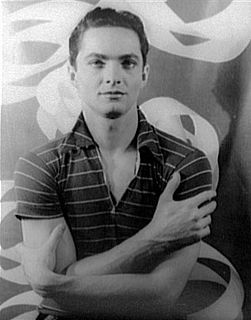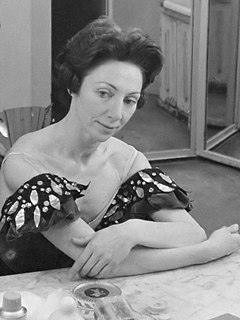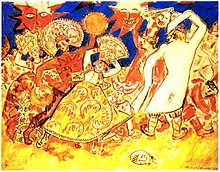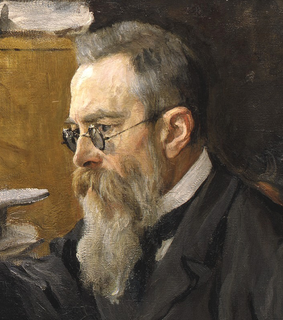
Sergei Pavlovich Diaghilev, usually referred to outside Russia as Serge Diaghilev, was a Russian art critic, patron, ballet impresario and founder of the Ballets Russes, from which many famous dancers and choreographers would arise.

Parade is a ballet with music by Erik Satie and a one-act scenario by Jean Cocteau. The ballet was composed in 1916–17 for Sergei Diaghilev's Ballets Russes. The ballet premiered on Friday, May 18, 1917 at the Théâtre du Châtelet in Paris, with costumes and sets designed by Pablo Picasso, choreography by Léonide Massine, and the orchestra conducted by Ernest Ansermet.

Wassily de Basil, usually referred to as Colonel W. de Basil, was a Russian ballet impresario.

George Zoritch, was a Russian-born American ballet dancer who starred in performances by Ballet Russe companies on stages all over the United States from the 1930s to the 1960s. Internationally known, he was one of the most glamorous figures and striking personalities in mid-twentieth-century ballet.

Natalia Sergeevna Goncharova was a Russian avant-garde artist, painter, costume designer, writer, illustrator, and set designer. Goncharova's lifelong partner was also a fellow Russian avant-garde artist Mikhail Larionov. She was a founding member of both the Jack of Diamonds (1909–1911), Moscow's first radical independent exhibiting group, the more radical Donkey's Tail (1912–1913), and with Larionov invented Rayonism (1912–1914). She was also a member of the German based art movement known as Der Blaue Reiter. Born in Russia, she moved to Paris in 1921 and lived there until her death.

Rosella Hightower was an American ballerina who achieved fame in both the United States and Europe.

The company Les Ballets Russes de Monte-Carlo was formed in 1932 after the death of Sergei Diaghilev and the demise of Ballets Russes. Its director was Wassily de Basil, and its artistic director was René Blum. They fell out in 1936 and the company split. The part which de Basil retained went through two name changes before becoming the Original Ballet Russe. Blum founded Les Ballets de Monte Carlo, which changed its name to Ballet Russe de Monte-Carlo when Léonide Massine became artistic director in 1938. It operated under this name until it disbanded some 20 years later.
Gaîté Parisienne is a ballet choreographed by Léonide Massine to music by Jacques Offenbach orchestrated by Manuel Rosenthal in collaboration with Jacques Brindejonc-Offenbach, the composer's nephew. With a libretto and décor by Comte Étienne de Beaumont and costumes executed by Barbara Karinska, it was first presented by the Ballet Russe de Monte Carlo at the Théâtre de Monte Carlo on 5 April 1938.
The Original Ballet Russe was a ballet company established in 1931 by René Blum and Colonel Wassily de Basil as a successor to the Ballets Russes, founded in 1909 by Sergei Diaghilev. The company assumed the new name Original Ballet Russe after a split between de Basil and Blum. De Basil led the renamed company, while Blum and others founded a new company under the name Ballet Russe de Monte-Carlo. It was a large scale professional ballet company which toured extensively in Europe, Australia and New Zealand, the United States, and Central and South America. It closed down operations in 1947.

La Boutique fantasque, also known as The Magic Toyshop or The Fantastic Toyshop, is a ballet in one act conceived by Léonide Massine, who devised the choreography for a libretto written with the artist André Derain, a pioneer of Fauvism. Derain also designed the décor and costumes for the ballet. Ottorino Respighi wrote the music based on piano pieces by Gioachino Rossini. Its world premiere was at the Alhambra Theatre in London on 5 June 1919, performed by Sergei Diaghilev's Ballets Russes.
A midnight sun occurs when the sun is visible at midnight, local time.

Pablo Picasso and the Ballets Russes collaborated on several productions. Pablo Picasso's Cubist sets and costumes were used by Sergei Diaghilev in the Ballets Russes's Parade, Le Tricorne, Pulcinella, and Cuadro Flamenco. Picasso also drew a sketch with pen on paper of La Boutique fantasque, and designed the drop curtain for Le Train Bleu, based on his painting Two Women Running on the Beach, 1922.

Chout, Op. 21, is the usual English-language title of a ballet by Sergei Prokofiev, written in two versions between 1915 and 1921. It is sometimes known as "The Tale of the Buffoon", or simply "The Buffoon". There also exists a symphonic suite from the ballet, Op. 21 bis, which is much more often performed than the full ballet score.
Nobilissima visione is a 50-minute ballet in six scenes by Paul Hindemith, originally choreographed by Léonide Massine for the Ballet Russe de Monte Carlo. The libretto by Hindemith and Massine depicts episodes from the life of Saint Francis of Assisi. The work was completed in February 1938 and premiered at Theatre Royal, Drury Lane in London on 21 July 1938, with sets and costumes by Pavel Tchelitchew and under the baton of the composer. He led one performance of the new ballet at the Metropolitan Opera House in New York on 14 October of the same year.

Vladimir Kostenko was a Ukrainian-born American ballet dancer primarily remembered for his long association with the Rodgers and Hammerstein musical Oklahoma!.
The Gay Parisian is an American short film produced in 1941 by Warner Bros. and directed by Jean Negulesco. The film is a screen adaptation, in Technicolor, of the 1938 ballet Gaîté Parisienne, choreographed by Léonide Massine to music by Jacques Offenbach. It was nominated for an Academy Award at the 14th Academy Awards for Best Short Subject (Two-Reel).

Nathalie "Natasha" Krassovska (1918–2005) was a Russian born prima ballerina and teacher of classical ballet most noted for her work with the Ballet Russe de Monte Carlo. Following her decades-long career, she moved to the U.S., where she founded the Krassovska Ballet Jeunesse. Krassovska taught, choreographed and performed until her death.

Sophie Pflanz, also known as Zofia Maria Pflanz-Dróbecka, was a Polish ballet dancer with the Ballets Russes from 1911 to 1917.















